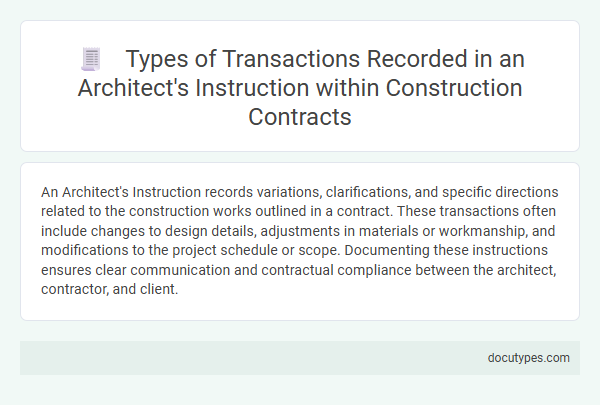An Architect's Instruction records variations, clarifications, and specific directions related to the construction works outlined in a contract. These transactions often include changes to design details, adjustments in materials or workmanship, and modifications to the project schedule or scope. Documenting these instructions ensures clear communication and contractual compliance between the architect, contractor, and client.
Variations to Design and Scope
What types of transactions are typically recorded in an architect's instruction? Variations to design and scope are the primary transactions documented. These include approved changes to project specifications, materials, or construction methods.
Instructions for Additional Works
Architect's Instructions document various transactions related to project modifications, especially instructions for additional works that arise during construction. These records ensure clear communication about scope changes and associated costs.
Instructions for additional works typically include details about extra tasks beyond the original contract, specifying materials, labor, and timelines. You must review these instructions carefully to understand the financial and operational impact on your project.
Approval of Materials and Workmanship
Architect's Instructions document essential transactions related to the approval of materials and workmanship in construction projects. These records ensure compliance with contract specifications and quality standards throughout the construction process.
- Material Approval - Specifies which construction materials have been reviewed and authorized for use, ensuring they meet project requirements.
- Workmanship Standards - Details the acceptable quality and methods of workmanship as agreed upon by the architect and contractor.
- Rejection and Substitution - Records any materials or workmanship rejected and approved substitutions, maintaining project integrity.
Change in Construction Methods
An architect's instruction records various transactions essential to project adjustments. One key focus includes changes in construction methods that impact the project timeline and costs.
- Modification of Techniques - Instructions detail shifts in construction methods to address unforeseen site conditions or design updates.
- Material Substitution - Recorded changes include using alternative materials that require different construction approaches.
- Process Alterations - Adjustments in the sequence or methodology of construction activities are documented for clarity and accountability.
Your contract benefits from clear records of these transaction types to ensure transparency and effective project management.
Revisions to Project Timeline
An Architect's Instruction records various types of transactions related to project execution, including revisions to the project timeline. These instructions serve as formal documentation that updates the schedule and adjusts key deadlines.
You may receive an Architect's Instruction when changes to the scope cause delays or when unforeseen circumstances require timeline adjustments. The document specifies revised milestone dates, extensions of time, and any impact on the overall project completion. Accurate recording of these timeline revisions ensures clear communication and effective project management.
Site Access and Possession Orders
Architect's Instructions typically record transactions related to changes or clarifications in the construction process. Site Access and Possession Orders detail when and how the contractor is granted access to the site and takes possession, ensuring work begins in a timely and organized manner. Your understanding of these instructions helps maintain clear communication and prevents disputes during the project.
Health, Safety, and Environmental Directives
An architect's instruction documents various types of transactions crucial for project management and compliance. These records often include directives focused on health, safety, and environmental standards to ensure site adherence and protection.
- Health Directives - Your architect's instruction outlines requirements related to worker health protocols and on-site medical preparedness.
- Safety Regulations - Instructions specify safety measures to prevent accidents, such as protective equipment use and hazard markings.
- Environmental Compliance - Transactions include guidelines to minimize environmental impact, waste management, and pollution control on site.
Compliance with Regulatory Requirements
| Type of Transaction | Description | Compliance with Regulatory Requirements |
|---|---|---|
| Variation Orders | Adjustments to the original scope of work as instructed by the architect. | Must adhere to building codes and local construction regulations to ensure legal execution. |
| Time Extensions | Modifications to project timelines to accommodate unforeseen delays or changes. | Require documentation that complies with contract conditions and statutory deadlines. |
| Cost Adjustments | Revisions in contract sum due to changes in materials, labor, or design. | Must align with financial regulations and auditing standards to validate expenses. |
| Quality and Safety Instructions | Directives related to material standards, workmanship, and site safety. | Ensure compliance with occupational health and safety laws and industry standards. |
| Material Substitutions | Approval or denial of alternative materials proposed during construction. | Ensure substituted materials meet regulatory requirements and performance specifications. |
| Inspection and Testing Requirements | Orders to conduct specific inspections or tests to verify compliance. | Fulfill mandatory regulatory inspections and certification processes. |
Rectification of Defective Work
An Architect's Instruction records transactions related to the rectification of defective work identified during construction. These transactions detail corrective measures required to bring the project in line with contractual specifications and quality standards. Documentation includes costs, timelines, and specific actions mandated to address and resolve defects efficiently.
What Types of Transactions Are Recorded in an Architect’s Instruction? Infographic

